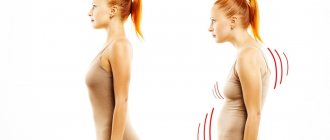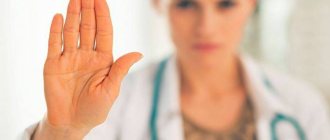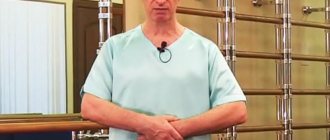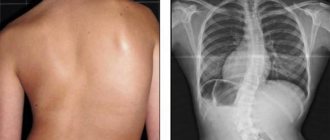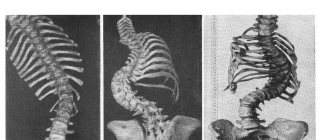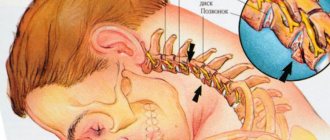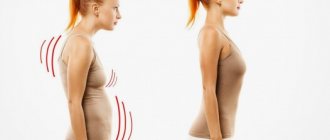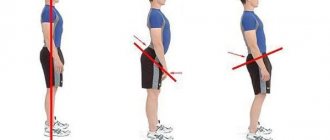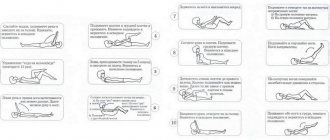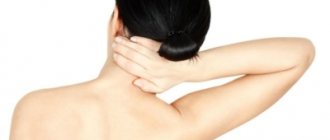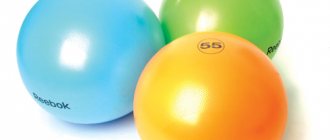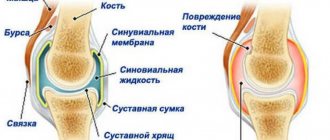Scoliosis 2 degrees is the result of the development of pathology, which is characterized by a lateral deviation of the vertical axis of the spine. If at the initial stage of the development of the disease it practically did not manifest itself, then at this stage the symptoms appear much more vividly and clearly - they can be identified during an examination by a specialist.
Spinal scoliosis of the 2nd degree is characterized by a curvature angle from 11° to 25° and the presence of torsion of the vertebrae. If you do not start treatment for stage 2 scoliosis, the consequences will be much more serious. They may be associated with the formation of a rib hump, a change in the volume of the chest (in the case of thoracic scoliosis of the 2nd degree).
At CELT you can get advice from a neurosurgeon.
- Initial consultation – 3,000
- Repeated consultation – 2,000
Make an appointment
Recommended exercise program for scoliosis in the gym
As mentioned above, the preparation of a training program should be individual for each patient, depending on the severity of the disease and the level of his physical fitness.
It is best if the selection of exercises is made by the attending physician, based on the clinical picture of the disease of a particular patient. A prerequisite is the presence of an experienced instructor at the training sessions, who will monitor the technique of performing the exercises and correct mistakes. Otherwise, training may be useless or cause even more serious damage to your health.
Any exercise in the fitness room should begin with a warm-up. This could be gymnastic exercises or riding an exercise bike.
At first, it is not recommended to use an elliptical trainer and treadmill for warming up, as they can put excessive stress on the spine. You can return to these exercise machines after 2-3 months, when your back muscles are sufficiently prepared.
After completing the warm-up exercises, you usually begin stretching. The most effective are bending in different directions and rotating movements of the head. Stretching should be performed for at least 5 minutes.
After completing the preparatory manipulations, you can begin the main training to correct scoliosis.
First day
For the first day of classes, the best options are:
- hack machine squats;
- leg press;
- seated dumbbell press;
- leg raises on the bar;
- bench press with a medium grip;
- lifting legs bent at right angles on the crossbar.
The order of exercises, the number of approaches and executions should be determined by the attending physician. The instructor must ensure that this or that exercise is performed correctly.
Second day
For the second day of training in the gym, the following are usually used:
- bench press from a lying position;
- dips;
- dumbbell rows;
- pull-up on the bar;
- seated dumbbell press with emphasis on the biceps.
The third day
This day of gym training includes the use of exercises from the first or second program with the addition of new ones:
- abduction of legs;
- bench press with dumbbells in a lying position;
- squats with a barbell on the shoulders (for beginners, the smallest weight is selected).
Useful exercises
In the fight against scoliotic curvature, push-ups from the floor will help well, since this involves the thoracic spine. Push-ups should not be performed every day, twice a week is enough. The number of approaches depends on the degree of vertebral deformity. Another effective exercise option is pull-ups. With its help, you can strengthen the muscle corset and stretch the spine.
It is important to remember that you should not jump off the machine abruptly, as this can provoke contraction of the ligaments and intervertebral discs, and this is very dangerous in case of scoliosis. It is also recommended to include the raider deadlift in your training program. When exercising on this simulator, the scapular muscles contract and compress the spine, helping to correct the deformity.
The training complex should include a large number of exercises aimed at strengthening the upper back muscles. This is the key to straightening the spine. You should not ignore neutral exercises with lifting dumbbells and light barbells. During the performance of neutral tasks, there is no compression of the spine; they are aimed at improving the general physical fitness of the patient.
Exercises while lying on your stomach:
- Lying on your stomach, lift your upper body and, rolling from side to side, alternately slide your palms along your thighs, reaching for the popliteal fossa. Repeat this 15-20 times.
- Lying on your stomach, place your arms along your body, toes resting on the floor (starting position). As you inhale, slowly straighten your legs, lifting your knees off the floor, keeping your pelvis pressed to the floor. As you exhale, return to the starting position. Do 5 times, 2-3 approaches.
- Lying on your stomach, move your legs to the side on the convex side of the lumbar spine, then return to the starting position. Repeat 5 times.
- Lying on your stomach, move your leg to the side on the side of the convexity in the lumbar spine, bend your arms at the elbows and join them at the back of your head in a lock. As you inhale, spread your elbows to the sides, slightly bending your spine, and stay in this position for a few seconds. As you exhale, return to the starting position. Repeat 5 times.
Knee lift. Illustration for exercise No. 3 in a supine position
Exercises for scoliosis 2 degrees
Therapeutic physical education (physical therapy) is subject to a number of special rules. If the patient does not follow these rules, then he will not only not be able to get rid of scoliosis, but will also harm his body. All these key principles must be observed:
- Before any exercise, a warm-up is necessary to prepare the ligaments and muscles. Starting physical exercise without warming up is pointless and even harmful.
- You need to do physical therapy slowly, without making sudden movements. Jumping and acrobatic elements are strictly contraindicated.
- High physical activity is also prohibited. When treating scoliosis, you should not lift weights, even if they are very small “room” dumbbells.
- You can start treatment with exercises only after talking with your doctor. Based on the medical history, the doctor will select the most effective activities that are fully suitable for a particular patient.
Attention: any sports activities should be started only after consulting a doctor. There are some cases when physical therapy is contraindicated.
Most often - with congenital scoliosis. And only an examination by a therapist can answer the question of whether a person can perform exercises. Therefore, self-medication is prohibited.
Class Rules
In order to get the maximum benefit from training and not cause harm to the body, you must follow a number of rules. Refusal to perform them may lead to deterioration of health and progression of the disease. Before starting classes, you must consult with a vertebrologist, orthopedist or rehabilitation specialist to select an individual training program.
The first few lessons must be conducted under the supervision of an instructor. The increase in load and duration of exercise should be gradual, sudden movements, jerks, and exercises with dumbbells and weights are excluded. The training consists of several stages: warm-up, main part, final part. If back pain appears or worsens as a result of exercise, you should stop exercising and consult a doctor.
A device that will help prevent scoliosis
The secret to successfully combating scoliosis is maintaining the correct posture. But it is quite difficult to constantly control exactly how you sit. But there is a device that can do this for you - Beurer PC 100 PostureControl .
The small gadget attaches to clothing and does not interfere with working at the computer, writing or reading. But if you sit for too long, the device will remind you to change your position and stretch your muscles with gentle vibration. The device is controlled through the 8sense application, and its benefits are confirmed by the opinion of physiotherapists and doctors.
Treatment of scoliosis of the lumbar spine
How to treat lumbar scoliosis? There are many techniques based on positive experience. First of all, you need to contact a specialist to determine all the intricacies of a particular case. Then follow the recommendations and prescriptions of your medical professional.
Effective methods of treatment are physical therapy exercises, wearing a leveling corset, massage, electrophoresis, and electrical muscle stimulation. Additionally, swimming, therapeutic exercises (in the gym and on the water), and manual therapy are prescribed. All procedures and sessions are prescribed depending on the degree of deformation.
Examples of exercises for the initial stage of lumbar scoliosis:
- You need to place your fingers on your shoulders, bending your elbows. Rotational movements should be made for 3-4 minutes. No sudden jerks! Smooth and soft.
- Stretch your entire body as closely as possible, but do not lift your heels from the floor. Fix in this position, then exhale and lower your arms. Repeat 10 times.
- Stand upright near the wall, touching your heels, buttocks and shoulder blades. Hold this position for 50-60 seconds. 10 approaches will be enough.
- Lie down on the floor. Stretch your legs up and pull up your socks. Hold this position for a minute and relax. 4-5 repetitions will be enough.
We advise you to study: I tore my back - how to treat it at home
For the first degree of scoliosis, massages, manual therapy or wearing a corset are not necessary.
Frequently prescribed procedures: breathing exercises, massage, electrical stimulation of the problem area. The doctor also selects a special corset designed to improve posture and support the back. Each corset is made to order, taking into account all anatomical features. The best effect from wearing a corset is achieved between the ages of 20 and 35 years.
Massages are prescribed by a specialist to maintain results after exercise therapy. During the session, the therapist must perform all movements smoothly and gently, without jerking, otherwise therapy can do more harm than good.
Most often, these exercises are prescribed to improve the patient’s condition:
- You need to stand on four points of support (hands and knees), bend at the lower back, then relax and repeat again. The number of repetitions is unlimited, perform until you feel tired.
- For this exercise you will need a gymnastic mat or foam. Having spread it on the floor, lie down and clasp your legs bent at the knees with your hands. Roll from left to right - from side to side.
- Another exercise on the floor. Lie on your back, raise your legs up - as straight as possible and slowly lower them first to one side and then to the other. 10 repetitions will be enough.
- Now roll over onto your stomach. Stretch your legs and arms, then simultaneously lift them, arching your back. It is necessary to perform the exercise until fatigue.
- Exercise "scissors". Lie on the floor, on one of your sides, fold your legs one on top of one another, while inhaling, lift them and swing in different directions (left leg forward, and right leg back). Perform until tired.
For degrees 3 and 4 of curvature, many procedures are used, including physical therapy exercises, which the doctor individually selects for the patient. All exercises are performed on the floor so as not to worsen the patient’s condition:
Lying on your back, you need to relax your stomach, and then tense it. You can control tension and relaxation using your hand.
The most important thing in the exercise is to breathe correctly. Lying on your back, press your legs to the floor - they should be motionless.
Tilts are made left and right. The number of repetitions is from 5 to 10.
Even despite the abundance of treatment methods, only 20% of patients manage to stop increasing the bending angle. The rest require surgery. Surgery is necessary to install a metal structure to align the spine. After surgery, a large amount of time is required for rehabilitation. During which individually developed sets of physical exercises are performed. And also physical therapy.
Warm-up
- Stand straight, feet shoulder-width apart, arms along your body.
Tilt your head forward and backward (do not throw your head back too much), while exhaling, tilt it forward, while inhaling, return to the starting position, while exhaling, tilt your head back, repeat 6-8 times (A).Tilt your head to the sides at a slow pace, as you exhale, tilt to the side, while inhaling, return to the starting position, and as you exhale, tilt to the other side. Do 6-8 times in each direction (B).
Turn your head slowly to the sides, right and left. Repeat 6-8 times (C).
Warm-up for scoliosis of the lumbar spine
- Bend the torso forward.
Stand straight, feet shoulder-width apart, hands behind your head, clasp them in a lock (starting position). As you exhale, slowly tilt your torso until it is parallel to the floor, your back should be straight, your legs should be slightly bent at the knees, your stomach should be tucked. As you inhale, return to the starting position. Repeat 10 times.
Torso bends
Treatment
Is it possible to cure stage 2 scoliosis? This stage of the disease is not advanced, so it responds well to therapy. Treatment of scoliosis is carried out mainly by conservative methods with specially designed gymnastics and physiotherapeutic procedures.
If the disease is stable, treatment is carried out on an outpatient basis. The progressive formation of deformities in scoliosis requires the use of a special artificial bandage that maintains the child’s posture in the correct position.
Without surgery
To correct grade 2 scoliosis, you can use the following set of exercises:
- Stand with your back to the wall. Shoulder blades, buttocks, calves, heels and head should be in contact with the wall. After taking several breaths and exhalations, you need to move your arms to the sides and tilt your body. Hold this position for 10 seconds.
- Hands behind your back, palms touching, fingertips pointing upward, shoulder blades toward each other.
- Kneel down, resting your palms on the floor, bend your back outward and inward.
- Lying on your stomach, raise your elbows up, rest your palms on the floor and point your chin straight.
- Sitting on a chair, you need to tense your abs and straighten your back. You should be in this position as often as possible and whenever possible.
- Throwing one arm over your shoulder and the other under it, clasp your hands, hold for 10 seconds, then alternate.
- Place a pillow under your back and stretch your arms and legs forward. Palms facing down, fingers straight.
- Lying on your side, place your hand under your head, slowly lift one leg up, then lower it. After 10 swings, turn over to the other side.
Physiotherapeutic procedures are also effective. Massage, manual therapy, mud therapy are useful. Manual therapy sessions are aimed at correcting the spine. There are no age restrictions. These are very effective procedures, the effect of which is observed after just a few sessions.
To strengthen bone tissue, chondroprotectors and calcium supplements can be prescribed. Taking vitamin supplements that strengthen the immune system is also useful. If you have very severe back pain, your doctor may prescribe mild painkillers.
Operations
Treatment of grade 2 scoliosis in adults and children does not require surgery. At this stage, the curvature is not yet very pronounced, so it can be corrected using conservative methods. Surgery may be required if stage 2 of the disease is not treated in time, causing it to progress to stage three.
Exercises while lying on your back:
- Lying on your back, place your hands under your sacrum, palms down. Raise your straight legs 15-20 degrees from the floor and rotate in a circle, 10 times to the right and 10 times to the left.
- Lying on your back, your hands rest your palms on your knees, your legs are raised and bent at an angle of 90 degrees. As you exhale, slowly lower, but not completely, the opposite arm and leg. As you inhale, return to the starting position and repeat on the other side.
- Lying on your back, place your arms along your body. As you exhale, pull your leg bent at the knee towards your chest, helping yourself with both hands. Change legs and repeat this 15-20 times.
Illustration for exercise No. 2 in a supine position
Tightening the knees. Illustration for exercise No. 3 in a supine position
Exercises for children
It is important to understand that exercises for children should be completely different. The child needs to reduce the load, there should be fewer exercises, as well as approaches to each of them
Some types of activities are generally unacceptable for a growing organism. Therefore, to select a set of classes, you need to consult with your pediatrician. Trying to treat a child on your own is strictly not recommended.
We should also not forget that congenital scoliosis and gymnastics often do not go together. Since children often have a congenital form of spinal curvature, physical education is not always suitable for them.
Scoliosis degrees
Depending on the stage of development of the pathology, orthopedic surgeons distinguish 4 degrees of scoliosis. Their separation is characterized by the angle of deviation of the spinal column from the vertical line:
- in the first degree, the deviation from the vertical is less than 10 degrees and is almost not noticeable in appearance;
- the second is diagnosed with a right- or left-side deviation of 11-25 degrees;
- with the third degree, this value varies from 26 to 50 degrees;
- exceeding the extreme indicator indicates the development of the fourth – last degree of scoliosis.
We advise you to study - Sciatica treatment at home
The first degree is sometimes considered not a pathology, but the limit of the norm, which does not require special treatment.
Its external symptoms are so mild that only a specialist can pay attention to them, and this often happens by accident during a medical examination of the child. At the same time, scoliosis is an insidious disease that, in the absence of qualified treatment, is prone to progression.
If grades 1-2 are not dangerous and can be completely treated conservatively, then grades 3 and 4 imply serious impairments in physical development, can only be treated surgically and can cause disability.
Why does scoliosis develop?
It is quite possible to avoid all these consequences, but to do this you need to eliminate the causes and do everything possible to restore the normal position of the spine. In most cases, scoliosis “grows out” of incorrect posture in a child, so in childhood it is important to pay attention to ensure that the child holds his back correctly when doing homework or watching TV. But adults should also brush up on how to sit at a desk correctly, especially if you spend most of the day in the office.
The cause of scoliosis is also called weakness of the spinal muscles, although to some extent this is a consequence of lack of physical activity. If you spend the day working on the computer, then get in the car and drive home, and spend the evening watching movies or using a smartphone in your hands, you don't give your muscles the slightest chance to maintain sufficient strength and keep your spine in the correct position.
Curvature of the spinal column develops against the background of inflammatory, infectious diseases, tumors, and injuries. Here you can no longer do without the help of a doctor, and the main task is to contact a specialist in a timely manner.
If curvature of the spine is your case, do not despair. There are quite affordable ways to correct your posture at home and even reduce the manifestations of scoliosis. And it's not as difficult as it might seem at first glance. Special exercises, modern equipment and attention to your own body will help you get your spine in order.
Exercise therapy for various stages of scoliosis development
Determining the degree of scoliosis ( three-plane spinal deformity in humans
) occurs based on the angle of inclination of the spine relative to the vertical, even spinal column.
Stage 1, according to doctoral concepts, does not pose any danger and is even considered normal. It is virtually impossible to see the degree of curvature with the naked eye. When the stage is advanced, exercise therapy is prescribed as a treatment.
The 2nd stage is the most pronounced, has a curvature angle of 20 -25. Healing is prescribed by the method of stretching and prescribing healing physical training.
Exercise therapy for first degree scoliosis
You need to keep in mind that self-medication can only worsen the situation. The set of exercises should be selected by the doctor after all the necessary examinations.
Let's look at some of them.
- On your back, stretch your head up and your heels down. Stretch for 8-10 seconds. Perform 4-5 stretches.
- Standing, one hand ( the upper limb of a person, the musculoskeletal system, one of the most important parts of the body
) at the top, the second at the bottom. Pull them back. Change position. - On your back, raise your legs above the floor and cross your legs. Repeat 3-4 times.
- Tilts the body left and right in a vertical position.
- On knees. Together, extend your right leg and left arm parallel to the floor. Change leg and arm.
- Position on your tummy, arms extended in front of you. Raise your chest and legs. Hold for 8-10 seconds. Descend.
- Tummy position. With your hands from behind, grab your ankle and lift your body off the floor. Stay for 10-15 seconds.
Exercise therapy for 2nd degree
In contrast to the complex at the first degree, physical exercises ( training (English training from train “to train, educate”) is a method of active learning aimed at developing knowledge, skills, as well as social attitudes
) are supplemented with breathing exercises.
Each exercise is performed 10-15 times.
- On your back, legs bent and raised. Move your legs like you would on a bike. Do this for 30-40 seconds.
- On the back ( ) is the intrinsic angular momentum of elementary particles, which has a quantum nature and is not associated with the movement of the particle as a whole
). Twisting the body to one side, we immediately stretch our right knee and left elbow towards each other. We change sides and limbs. - While standing, lower your body forward parallel to the floor. Raise one leg up and extend the opposite arm forward. Hold the position for 10-15 s. Change legs and arms.
- Lean tightly against the wall. Slide down without lifting your shoulder blades and buttocks until the angle between your knees is even. Climb back up.
- On all fours, bend your back up and down, as in the “cat” exercise.
- On the floor, place the ankle of one foot on a chair. Lower your body towards the raised leg. Swap your legs.
- While standing, raise your arms bent at the elbows up and move them very back.
Side lying exercises:
- Lie on your side, with the convex curvature of the lumbar spine facing upward. As you inhale, lift one or two legs up, but don’t lift them too high! As you exhale, return to the starting position. Repeat 5-6 times.
- Lie on your right side, stretch your right and left arms in front of you so that they are parallel and do not touch each other. Bend your left leg at the knee and move it to your right side, with your left shin and foot resting on the floor (A). Then turn your torso to the left side and hold in this position (B). After completing one set, turn onto your left side and repeat the same on the other side. Do 4 times on each side.
Illustration for exercise No. 2 in the side position
Risk factors, causes and consequences of right-sided scoliosis
Right-sided lumbar scoliosis
Right-sided lumbar curvature is most often observed in patients whose work activity does not allow them to exercise physical activity during the working day.
This type of deformation is usually accompanied by the following phenomena:
- painful sensations in the lower back (typical for the 1st degree of the disease);
- violations of posture and figure contours due to spinal deformity;
- symptoms of early osteochondrosis (often observed in the 2nd degree of pathology).
If left untreated, the long-term consequences of this type of scoliosis can be herniation and protrusion of intervertebral discs, as well as spondylolisthesis (displacement of one vertebra forward or backward).
Right-sided thoracic scoliosis
Right-sided thoracic scoliosis usually occurs in children and adolescents; most often the disease targets girls.
Reasons for the development of pathology:
- incorrect posture when doing homework, when the spine is twisted to the right side, the right forearm lies on the table, and the right shoulder is pushed forward;
- rapid growth of a child of asthenic build, with a poorly developed muscle corset;
- hormonal disorders during puberty;
- idiopathic (unknown, unclear) causes.
Consequences of right-sided thoracic scoliosis without adequate treatment:
- progressive course and transition to more severe stages of the disease;
- disorders of the blood supply to the spine;
- pinching of nerve roots by vertebrae;
- displacement of internal organs and their secondary pathologies;
- damage to the cardiovascular, respiratory, digestive, immune and nervous systems;
- disability due to paralysis of the limbs, as well as dysfunction of the pelvic organs (uncontrolled urination and defecation).
Separately, we should mention the congenital causes of scoliotic disease, when disruptions in the period of intrauterine development lead to pathological changes in the spine.
Therapeutic swimming
For all types of spinal diseases, therapeutic swimming is recommended. This is the most effective way to relieve stress from the spine and relax all the muscles of the body. A contraindication to such a useful activity can only be severe injury or instability of the vertebrae.
Entire sets of exercises can be performed in an aquatic environment. All exercises in the pool are performed under the guidance of an instructor; you should not self-medicate or use techniques without the supervision of a specialist.
- Lying on the water in the “star” position.
- Swimming using the breaststroke technique.
- Swimming on your back, using your arms as oars.
- Somersaults back and forth.
- Breathing exercises (holding your breath).
- Exercises with special equipment.
The full treatment complex consists of gymnastics, massage, swimming and physiotherapy. Since scoliosis of the 2nd degree negatively affects mainly the respiratory function, in order to strengthen the therapeutic result, it is necessary to use breathing techniques. They will also be useful when performing gymnastics and yoga asanas. It is recommended to perform all the exercises in combination and daily, only then will the maximum treatment effect be achieved.
Relaxing muscles at home
Those who work remotely and spend whole days at their desks should also take care of their spinal health. To do this, you need to know how to relax your back muscles at home and avoid overstraining them.
The best solution for this situation is massage, but not everyone has the opportunity to use the services of a massage therapist every day. Special massage pillows can replace such a session. For example, model Beurer MG 149
She will give you a shiatsu massage while you work or relax.
The pillow contains special massage heads that reproduce the basic movements of the shiatsu technique: pressing and kneading. To a certain extent, such a device can do even more than a massage therapist. Pillow:
- Performs a deep massage, automatically changing the direction of movement of the heads;
- Easily controlled from the remote control built into the belt;
- It has a heating function, which enhances the massage effect and activates blood circulation;
- Allows you to adjust the rotation of the heads;
- It is fixed on the body, so you can safely continue to do your business while the device works your muscles.
Using such a pillow for just a few minutes a day, you will very soon feel that your back is less tired and the pain has gone away. Working out the muscles will stimulate them and help maintain the correct position of the spine.
What is exercise therapy
Therapeutic exercise is an integral part of the therapy and prevention of many diseases using physical education methods (often in combination with massage and physiotherapeutic procedures); properly selected physical exercises can restore the patient’s health and performance.
When selecting exercises, the pathogenesis, etiology, clinical features, functional state, and overall performance are taken into account; this is what differs from conventional physical education. The exact dosage also plays an important role depending on the diagnosis and characteristics of the patient’s body, since the individual level of the norm may differ from the average.
For some it is difficult to lift 1 kg, while for others it is easy to lift 50; for one, running 200 m is a whole marathon; for another, a marathon may seem like an element of exercise therapy. That is why a set of exercises is selected by a doctor; physical therapy exercises are allowed at home, provided that the recommendations are followed.
Goals of exercise therapy for scoliosis:
- elimination of imbalance of ligaments and muscles;
- removing excess load on the spine;
- posture correction;
- strengthening the back muscle corset;
- general health effects on the body.
Before performing exercise therapy, a warm-up is required to warm up the ligaments and muscles; the exercises are performed at a slow pace, sudden movements, jumping and elements of acrobatics are excluded. Serious loads are excluded, dumbbells and barbells are not used, and the type of scoliosis is taken into account when selecting a complex.
Massage cape as a prevention of scoliosis
Those who strive for maximum comfort should pay attention to the massage cape. This device relieves tension not only in the back and lower back, but also in the neck and shoulder girdle. You will certainly appreciate the many settings of the cape, which make it possible to adjust its functions to suit you.
So, in the Beurer MG 254
Can:
- Set the desired massage intensity;
- Switch the direction of movement of the heads;
- Select a massage area;
- Turn heating on and off;
- Adjust height;
- Set a timer for a specific time to work out the muscles.
The cape can compensate for lack of physical activity, normalize blood pressure, improve sleep quality and increase skin elasticity. By working the muscles, fatigue and tension disappear, the posture while sitting becomes more correct and relaxed, which means the load on the spine is reduced.
Advice from medical experts
The following advice from medical specialists will reduce the duration of treatment:
- You should engage in therapeutic physical training every day.
- It is advisable to sleep on a semi-rigid chair or bed.
- While working or doing any activity, you need to monitor your posture. At first it seems impossible, but over time you form the habit of checking the condition of your back.
- It is recommended to wear the corset while working or exercising. It is not necessary when lying down.
- A back massage is highly recommended.
- An orthopedic medical specialist should be consulted throughout the course of treatment.
- You should also adhere to a proper diet.
- It is advisable to give up smoking, as well as alcohol abuse.
- Taking calcium will speed up the healing process.
Before starting exercise therapy, you should consult with a medical specialist in advance. The orthopedist will independently compose the necessary set of exercises.
Scoliosis - clinics in
Choose among the best clinics based on reviews and the best price and make an appointment
Family
Oriental Medicine Clinic "Sagan Dali"
Moscow, prosp.
Mira, 79, building 1 Rizhskaya
+7
- Consultation from 1500
- Diagnostics from 0
- Reflexology from 1000
0 Write your review
Family
Back and joint treatment clinic No. 1
Moscow, Pyatnitskoye sh., 6, bldg.
1 VolokolamskayaMitino
+7
- Consultation from 1000
- Treatment courses from 7000
- Massage from 1500
10 Write your review
Family
Institute of Traditional Oriental Medicine
Moscow, Filippovsky lane, 18
Arbatskaya (FL)
8-(495) 691-66-69
registry
- Consultation from 1200
- Manual therapy from 1300
- Physiotherapy from 700
0 Write your review
Show all Moscow clinics
When is surgery necessary?
If conservative methods do not help, spinal surgery is performed.
According to statistics, surgery is necessary in only 0.15% of diseases. Most surgical interventions are prescribed on the initiative of the doctor, because... Conservative therapy was not fully used. Before the operation, patients or the child’s parents are informed about the reasons for the procedure and possible complications after the procedure.
The need for surgery is dictated by the following conditions:
- debilitating chronic pain;
- loss of bowel or bladder control;
- weakness of the limbs due to compression of the nerves and spinal cord;
- changes in the functioning of the heart, lungs, impaired motor functions.
